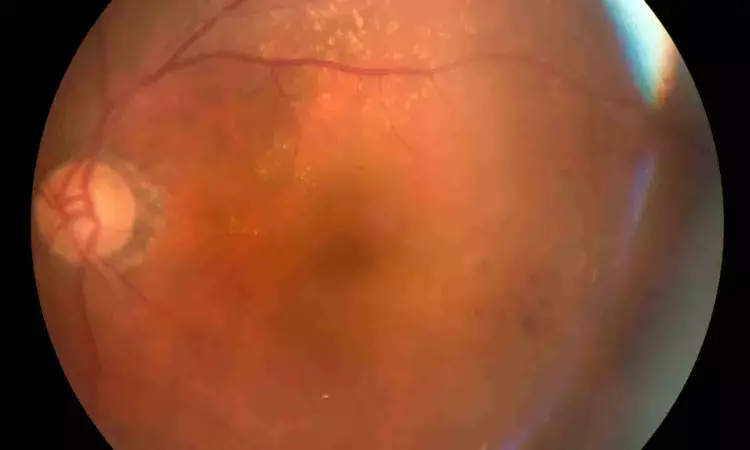- Home
- Medical news & Guidelines
- Anesthesiology
- Cardiology and CTVS
- Critical Care
- Dentistry
- Dermatology
- Diabetes and Endocrinology
- ENT
- Gastroenterology
- Medicine
- Nephrology
- Neurology
- Obstretics-Gynaecology
- Oncology
- Ophthalmology
- Orthopaedics
- Pediatrics-Neonatology
- Psychiatry
- Pulmonology
- Radiology
- Surgery
- Urology
- Laboratory Medicine
- Diet
- Nursing
- Paramedical
- Physiotherapy
- Health news
- Fact Check
- Bone Health Fact Check
- Brain Health Fact Check
- Cancer Related Fact Check
- Child Care Fact Check
- Dental and oral health fact check
- Diabetes and metabolic health fact check
- Diet and Nutrition Fact Check
- Eye and ENT Care Fact Check
- Fitness fact check
- Gut health fact check
- Heart health fact check
- Kidney health fact check
- Medical education fact check
- Men's health fact check
- Respiratory fact check
- Skin and hair care fact check
- Vaccine and Immunization fact check
- Women's health fact check
- AYUSH
- State News
- Andaman and Nicobar Islands
- Andhra Pradesh
- Arunachal Pradesh
- Assam
- Bihar
- Chandigarh
- Chattisgarh
- Dadra and Nagar Haveli
- Daman and Diu
- Delhi
- Goa
- Gujarat
- Haryana
- Himachal Pradesh
- Jammu & Kashmir
- Jharkhand
- Karnataka
- Kerala
- Ladakh
- Lakshadweep
- Madhya Pradesh
- Maharashtra
- Manipur
- Meghalaya
- Mizoram
- Nagaland
- Odisha
- Puducherry
- Punjab
- Rajasthan
- Sikkim
- Tamil Nadu
- Telangana
- Tripura
- Uttar Pradesh
- Uttrakhand
- West Bengal
- Medical Education
- Industry
Half-dose photodynamic therapy clinically useful therapy for chronic central serous chorioretinopathy, suggests study

Researchers have found that half-dose photodynamic therapy (PDT) results in faster and more effective resolution of subretinal fluid (SRF) in patients with chronic central serous chorioretinopathy (CSCR) compared to subthreshold micropulse laser therapy (SMLT). The recent study was published in Ophthalmology Retina journal by Marten E. and colleagues. This prospective, double-masked, randomized, controlled clinical trial aimed to compare the anatomic and functional outcomes of these two treatments in patients diagnosed with chronic CSCR.
Chronic CSCR is a condition characterized by the accumulation of SRF under the retina, leading to vision impairment. Current treatments include PDT and SMLT, but their comparative efficacy has not been conclusively determined. This study, conducted between April 2017 and October 2020, sought to fill this knowledge gap by evaluating the effectiveness of half-dose PDT versus SMLT.
Eligible patients were randomly assigned to receive either half-dose PDT or SMLT. The treatments were repeated if persistent SRF was observed. Evaluations were conducted one month after treatment and every three months thereafter until the 12-month endpoint. The primary outcome measure was the complete resolution of SRF on OCT scan at 12 months. Secondary outcomes included changes in best-corrected visual acuity (BCVA), central macular thickness (CMT), retinal sensitivity, and vision-related quality of life.
• A total of 68 patients were enrolled in the study. At the 1-month mark, SRF resolved in 24.2% of patients receiving SMLT and 58.8% of patients receiving half-dose PDT
• By 12 months, SRF resolution was observed in 82.1% of the SMLT group and 90.9% of the half-dose PDT group.
• Kaplan-Meier survival curves indicated significantly faster SRF resolution in the half-dose PDT group compared to the SMLT group (P = 0.016).
• Both treatment groups showed significant improvements in BCVA, CMT, and retinal sensitivity at 12 months.
• Specifically, BCVA improved by −0.12 ± 0.21 in the SMLT group and −0.13 ± 0.12 in the half-dose PDT group.
• CMT decreased by −154.2 ± 105.6 in the SMLT group and −140.8 ± 94.0 in the half-dose PDT group.
• Retinal sensitivity increased by 5.70 ± 5.02 in the SMLT group and 6.05 ± 3.83 in the half-dose PDT group.
• There were no significant differences between the two groups at each time point in terms of BCVA, CMT, and retinal sensitivity, except for BCVA at 3 months (P = 0.03).
The findings indicate that both half-dose PDT and SMLT are viable treatment options for chronic CSCR. However, half-dose PDT provides faster anatomic success and functional improvement, making it a potentially more effective treatment option for this condition. The study highlights the importance of personalized treatment plans for patients with chronic CSCR, taking into consideration the speed of recovery and overall efficacy of the therapy.
This study demonstrates that half-dose PDT achieves faster resolution of SRF and functional improvement in chronic CSCR patients compared to SMLT. Both treatments are effective, but half-dose PDT offers a quicker pathway to anatomic success, suggesting it may be the preferred option in managing chronic CSCR.
Reference:
Brelen, M. E., Ho, M., Li, S., Ng, D. S. C., Yip, Y. W. Y., Lee, W. S., Chen, L. J., Young, A. L., Tham, C. C., & Pang, C. P. (2024). Comparing half-dose photodynamic therapy with subthreshold micropulse laser for the treatment of central serous chorioretinopathy. Ophthalmology Retina, 8(5), 490–498. https://doi.org/10.1016/j.oret.2023.10.024
Dr Riya Dave has completed dentistry from Gujarat University in 2022. She is a dentist and accomplished medical and scientific writer known for her commitment to bridging the gap between clinical expertise and accessible healthcare information. She has been actively involved in writing blogs related to health and wellness.
Dr Kamal Kant Kohli-MBBS, DTCD- a chest specialist with more than 30 years of practice and a flair for writing clinical articles, Dr Kamal Kant Kohli joined Medical Dialogues as a Chief Editor of Medical News. Besides writing articles, as an editor, he proofreads and verifies all the medical content published on Medical Dialogues including those coming from journals, studies,medical conferences,guidelines etc. Email: drkohli@medicaldialogues.in. Contact no. 011-43720751


